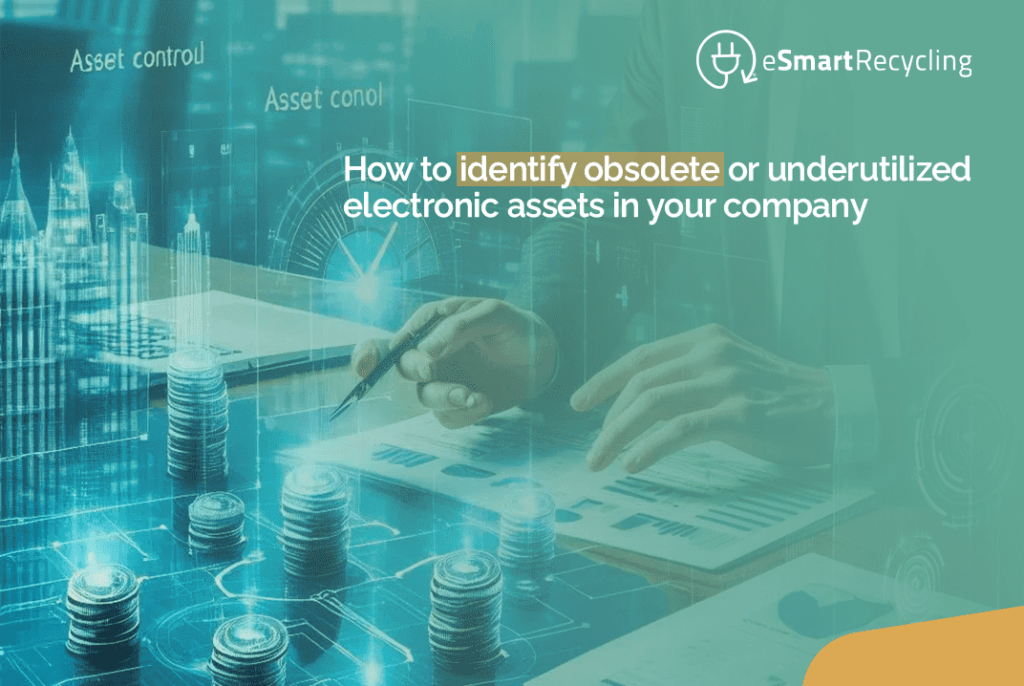
In the digital transformation era, countless companies seek ways to maximize the value of their electronic assets. The opportunity to save significant costs and increase efficiency through these assets is too good to pass up. By identifying obsolete or underutilized electronic resources, businesses can redirect their resources toward more effective purposes.
Identifying obsolete resources can be daunting. This article offers key tips and recommendations on effectively identifying obsolete or underutilized electronic assets in your company.
To effectively identify obsolete and underutilized electronic assets, it’s crucial first to define what these assets are. Obsolescence refers to the condition where an asset has become outdated or no longer useful or relevant to business operations. On the other hand, an underutilized asset should be used to its full potential. In other words, its capabilities still need to be explored, which may still hold relevance for the company’s operations.
Creating an inventory of your electronic resources will provide a clear picture of your current assets and allow you to evaluate their utility and relevance to your company’s operations. This inventory should include an assessment of each asset’s usage level, maintenance costs, and potential use.
Take the time to review how your company’s electronic resources are currently being used. This will give you a good idea of each asset’s purpose, relevance, and efficiency. Look for possible areas of improvement and see if there are ways to use the asset to enhance your operations’ productivity.
To maximize the value of electronic resources, companies should proactively evaluate which assets should be phased out of their operations. Generally, an asset should be phased out when it is obsolete and no longer useful or relevant to the company. On the other hand, underutilized assets can be repurposed or upgraded to become an effective part of operations.
To evaluate when an asset should be phased out, consider the following:
While disposing of underutilized assets may not always be necessary, it’s important to consider their potential use. It is good practice to evaluate whether these assets could add additional value if repurposed. For example, you could use an underutilized server for data storage in a backup solution or an underutilized device as a tester.
Maximizing the value of your company’s electronic resources is a worthy and achievable goal. To start, it’s important to know which assets in your company are obsolete or underutilized and take a proactive approach to evaluate their relevance and potential uses. By following the tips and recommendations in this article, you will be well on your way to effectively identifying these assets and redirecting your resources toward more effective purposes.
Are you a business owner or office manager wondering how to properly dispose of old office electronic devices? At eSmart Recycling, we provide IT Asset Disposition (ITAD) services in the United States. We offer environmentally and socially responsible solutions to securely recycle and reuse electronic devices like printers, computers, and more. Focusing on responsible end-of-life processes and committed to the highest levels of data security, we are proud to be your trusted partner for safe and reliable recycling.
Each year, businesses discard thousands of electronic devices. Computers, faxes, printers, and other devices often end up in landfills, contributing to the growing problem of electronic waste. At eSmart Recycling, we offer a more sustainable alternative. Our team of experts can work with you to ensure that your obsolete or broken electronic devices are processed responsibly. We take pride in helping businesses reduce their environmental impact.
eSmart Recycling can recycle a wide range of office electronics. This includes printers, computers, laptops, faxes, tablets, scanners, and more. We are committed to providing responsible recycling services and ensuring that the electronics we process never end up in a landfill. Our team is prepared to dispose of your electronic devices safely and without negatively impacting the environment.
eSmart Recycling offers a simple and transparent process for recycling your office electronics. Our team will work with you to determine the most convenient process for your business. We offer free nationwide pickup services, or you can drop off stored electronic devices at one of our secure facilities. We also provide a Data Destruction Certificate to ensure that your company’s confidential information is safe.
There are many good reasons to choose eSmart Recycling for recycling your office electronic devices. We are committed to offering environmentally responsible solutions. We ensure that all electronic devices we process are recycled properly. Additionally, we are dedicated to helping businesses reduce their environmental impact. Recycled electronics are suitable for reuse, reducing the demand for new electronic devices and promoting a healthier environment.
We also provide a range of benefits to our customers. We offer a flexible pickup service and can collect your obsolete or broken electronic devices nationwide. We also provide a variety of secure services, such as a Data Destruction Certificate and processing at secure facilities. Every service we offer is designed to make your process as convenient and secure as possible.
Recycling your office electronic devices has never been easier. At eSmart Recycling, we offer a range of secure and convenient recycling services. Our team of experts can work with you to ensure that your obsolete or broken electronic devices are responsibly recycled. We offer a variety of secure services, including a Data Destruction Certificate to ensure that your company’s confidential information is safe. With eSmart Recycling, you can trust that your obsolete or broken electronic devices will be recycled in an environmentally friendly manner.
Contact us today to learn more about our ITAD services and how we can help you properly dispose of your old office electronic devices. We would be honored to be your trusted partner for safe and reliable electronic waste recycling.
Worldwide, the trade of electronic devices has seen a massive increase in recent decades. This growth in the use of electronic waste is contributing to an alarming amount of pollution in oceans globally, with catastrophic consequences for marine life and the environment. In this article, we will analyze the impact of electronic waste on oceans and examine how we can mitigate it.
Electronic waste, or e-waste, is the waste material produced by the disposal of used and obsolete electrical and electronic equipment such as televisions, computers, and printers. The United Nations Environment Programme estimates that around 500,000 tons of electronic waste are disposed of each year, with experts believing this could triple by 2025. When dumped in landfills or shipped to developing countries to be burned or buried, e-waste releases toxic chemicals that can contaminate the air, water, and soil.
Currently, it is estimated that 80% of electronic waste is exported to developing countries, where many economies depend on the use of electronic products like phones, laptops, and televisions. However, older models that have reached the end of their life cycle are often discarded, leaching a toxic mix of chemicals into the ground. Some of these chemicals are washed into the shore and end up in the ocean. Many of these toxic substances do not easily break down and accumulate in fish and invertebrates. This transfer through the food chain eventually affects human and animal health.
Fish caught in areas near e-waste dumps can have excessive levels of chemicals such as sulfur, lead, and cadmium. These chemicals can be hazardous to humans who consume the fish. Additionally, exposure to these chemicals can damage reproductive, endocrine, and nervous systems, as well as immune and other bodily functions.
To mitigate the environmental impact of electronic waste, the best option is to recycle electronic items. Recycling e-waste not only helps safeguard the environment but also recovers valuable resources, reduces the need for raw material extraction, and significantly decreases the emission of harmful chemicals.
Additionally, many electronic devices are still usable even if their owners no longer want them. Instead of discarding them, they can be easily donated to charities or resold. Many organizations accept old and functioning computers to donate to schools or small businesses in need. Moreover, many tech companies have recycling programs to prevent e-waste from becoming major pollutants. For instance, Apple accepts old iPhones, and Hewlett-Packard accepts electronic equipment of any brand, ships it, and recycles it for free.
Electronic waste is a significant problem for humanity. Without addressing the current issue, it will only worsen soon. It is crucial to start a conversation and educate people about the negative consequences that electronic waste has on our planet, and the steps we can take to improve the situation. Collaboration between individuals, organizations, businesses, and governments is needed to reduce electronic waste levels. Every action, from donating old electronic devices to learning and practicing conservation, will have a positive impact on the environment.
Regarding saving the Earth, we’re all familiar with the three R’s of recycling: reduce, reuse, and recycle. However, many people may not realize that the electronics industry also contributes to the ecological health of the planet, as well as the health and well-being of people worldwide. A significant contributor to this is the recycling of lithium-ion batteries, an essential process for keeping our electronic devices running in an environmentally friendly way.
So, if you have electronic devices that use lithium-ion batteries, it’s important to understand what lithium-ion battery recycling is and why it is crucial for our global community. This article will answer all your burning questions and tell you everything you need to know about lithium-ion battery recycling.
Batteries are a fundamental component of electronic devices, and lithium-ion batteries are becoming increasingly popular. This is why lithium-ion battery recycling is such an important phenomenon. It is the process by which the valuable materials contained in a lithium-ion battery are safely recovered from the battery so they can be reused or reprocessed into new batteries. Materials that can be recovered from lithium-ion batteries include cobalt, nickel, and lithium metal oxides. This is especially important due to the high demand for these materials in the electronics industry.
We’ve all heard about the importance of battery recycling for the environment, but the reality is that lithium-ion battery recycling is even more crucial. Besides the typical environmental benefits of recycling—such as reducing the impact of raw material extraction and processing on the planet—lithium-ion battery recycling also helps ensure a consistent supply of raw materials for the electronics industry. Both the extraction and processing of these raw materials can be extremely harmful to the environment, making it vital to find alternative ways to obtain them.
Additionally, the number of electronic devices in the world using lithium-ion batteries is rapidly increasing, which means the demand for the materials used in these batteries is also rising. This growing demand is driving the need for lithium-ion battery recycling. Without recycling, we would quickly run out of raw materials and have to revert to extracting and processing them, further damaging the planet.
The process of recycling lithium-ion batteries involves several stages. First, the batteries are collected and sorted at a recycling facility. All the valuable materials in the batteries—such as cobalt, nickel, and lithium metal oxides—are separated from the battery itself. Various chemical and mechanical methods are used to extract these materials from the battery. These materials can then be reused or processed into new batteries.
When it comes to recycling your electronic devices, including those with lithium-ion batteries, it’s important to ensure you do it responsibly. One option is to take your devices to a recycling facility or program. Most municipalities have these facilities and programs to help almost everyone participate in the recycling movement.
Moreover, several electronic device manufacturers also offer recycling programs. For example, Apple has a recycling program where they collect your old iPhone and recycle the materials for you. Similarly, Sony has an extensive electronic device recycling program includes a donation option to an approved charity.
Recycling lithium-ion batteries is crucial as it helps reduce the impact of raw material extraction on the planet and ensures a steady supply of materials for the electronics industry. Understanding what lithium-ion battery recycling is, its importance, and how the process works is essential information for anyone who owns electronic devices. By recycling your electronic devices, including those with lithium-ion batteries, you can help protect the planet and its resources.
Many people might not realize it, but when electronic devices are discarded or recycled, they can have a significant impact on the environment. Electronic recycling is an excellent way to reduce soil pollution and its effects on the environment. If electronic devices are not disposed of properly, the toxic chemicals they contain can seep into the soil, causing severe environmental damage. In this article, we will explore how electronic recycling can help reduce soil pollution and its impact on the environment.
Electronic recycling, also known as e-waste recycling, is the practice of recovering useful materials from old or broken electronic devices and recycling them for use in new products. Electronics, such as computers, mobile phones, and televisions, contain materials like lead, mercury, cadmium, and other hazardous substances that can contaminate the environment if not disposed of properly. Electronic recycling helps prevent these materials from entering the environment and causing harm.
When electronic devices are not disposed of correctly, their hazardous materials can contaminate the soil. Electronic recycling helps prevent this by recovering useful materials from old devices and processing them for use in new products. This saves energy and keeps toxic materials out of the soil.
Soil pollution has a range of negative environmental impacts. When toxic materials leach into the soil, they can harm plants, wildlife, and human health. Some of the most common toxic chemicals found in electronics, such as lead, cadmium, and mercury, can cause various health problems, including respiratory issues, developmental delays in children, and cancers.
To help reduce soil pollution from electronic waste, several e-waste management solutions have been implemented. Many companies now have recycling programs that allow citizens to recycle their old electronic devices. These programs typically involve dropping off old electronics at local collection points or using mail-back services to properly dispose of them.
Electronic devices contain many hazardous materials that, if not disposed of properly, can contaminate the soil and cause significant environmental and human health damage. Electronic recycling is an excellent way to help reduce soil pollution from electronic waste and its associated impacts. Companies can help by offering e-waste recycling programs, and consumers can take advantage of these programs by properly disposing of their electronic devices. By practicing responsible e-waste management, we can help reduce soil pollution and protect the environment for future generations.
As businesses become more aware of their environmental impact, they take recycling and material reuse more seriously. Both strategies to reduce waste and carbon footprint have their pros and cons. So, should your business focus on reusing materials or working to recycle them? This article will analyze reuse versus recycling to determine which option is better for your business.
Reuse involves using something again, either in its original state or adapted for a different use. This practice can reduce the amount of waste a company produces and save money at the same time. Reuse can involve things like office supplies, clothing, electronics, and construction materials. Some companies even seek out items that others have discarded, which is how businesses like Goodwill and The Salvation Army make money.
Recycling is the process of reprocessing old and used materials to make new products. It reduces the amount of waste that ends up in landfills and decreases the use of raw materials to create new products. Commonly recycled materials include paper, glass, aluminum, metal, and plastic. Some modern companies have even started recycling organic materials, like wood waste and food scraps.
The primary benefit of reuse is that it reduces the amount of materials a company throws away and can save money. Additionally, many businesses look for new and innovative ways to reuse items that others might have discarded, keeping them out of landfills and saving resources. However, the downside of reuse is that it can be time-consuming for businesses to find new uses for old items. The quality of reused items can sometimes be inferior to new ones, and it can be challenging to find genuinely reusable items, as some may need repairs or upgrades to be reused.
The biggest benefit of recycling is that it reduces the amount of waste going to landfills, saving valuable space. Recycling also helps conserve natural resources and reduces greenhouse gas emissions. However, the drawbacks of recycling include the high energy consumption required for transportation and processing. Additionally, not all items are recyclable, and the quality of some recycled materials can be inferior to non-recycled materials.
Deciding whether a business should focus on reuse or recycling can be a tough decision. However, in most cases, the best approach for a business is to do both. Companies should consider the materials they have and whether they can be reused or recycled. Many businesses also choose to focus on reusing items that cannot be recycled and recycling those that can. By using both reuse and recycling, companies can significantly reduce their environmental impact and save resources at the same time.
Both reuse and recycling are strategies for businesses to reduce waste and conserve resources. Each option has its pros and cons, but in most cases, companies should focus on both. Reusing items can help save money and reduce waste, while recycling can help conserve resources and reduce landfill waste. By utilizing both strategies, businesses can have a positive impact on the environment and save money in the process.
In today’s society, electronic devices play a significant role in daily life. From smartphones and tablets to laptops and appliances, the amount of electronic waste we produce annually can be staggering. Therefore, electronic waste recycling is increasingly important for conserving natural resources. This article explores the impact of electronic waste recycling on the environment and its benefits.
Electronic waste, also known as e-waste, is often discarded in landfills. This can negatively impact natural resources, as electronic devices contain valuable materials like metals and chemicals. In many cases, these resources are irreplaceable, which leads to various adverse environmental effects. Additionally, discarded electronic waste can cause health problems for humans and animals.
Electronic waste recycling involves collecting and reusing electronic devices for parts and components. This process includes breaking down electronic devices, separating and recovering valuable materials, and repurposing them for various uses. By recycling electronic devices, we can conserve resources and eliminate the negative environmental impact of discarded e-waste.
There are several ways to recycle electronic devices, such as donating or selling the device to a third party or returning it to the manufacturer for recycling. Additionally, many municipalities offer electronic waste recycling programs to encourage the responsible disposal of electronic devices.
Electronic waste recycling has several positive impacts on the environment and the conservation of natural resources. First, recycling electronic devices helps conserve valuable raw materials like gold, platinum, and nickel. Additionally, recycling electronic devices can also reduce energy consumption. When electronic devices are recycled, they are broken down and reused, saving the energy used to extract and refine materials.
Moreover, recycling electronic waste helps reduce the amount of potentially hazardous materials dumped in landfills. When these materials are disposed of improperly, they can severely impact the environment, contaminating air and water sources. By recycling these materials, we can eliminate their negative environmental impact.
In addition to environmental benefits, electronic waste recycling has several economic and social benefits. Recycling electronic devices can help create jobs in the recycling industry and reduce the production costs of new electronic devices. Additionally, recycling electronic devices has a reduced environmental impact, which can save money in the long run by reducing the need for waste disposal programs and mitigating the effects of pollution.
Many manufacturers offer electronic waste management programs to encourage the responsible disposal of electronic devices. For example, Apple, Samsung, and HP have partnered with the Electronic Product Stewardship Association to offer mail-in programs that help reduce the environmental impact of electronic waste.
Electronic waste recycling is increasingly important for conserving natural resources and the environment. Recycling electronic devices helps conserve valuable raw materials, reduces energy consumption, and eliminates negative environmental impacts. Additionally, electronic waste recycling offers numerous economic and social advantages, such as job creation and long-term cost reduction. Both individuals and businesses should responsibly dispose of electronic devices by utilizing the various electronic waste recycling programs available.







If you want to know more about the different programs, partners, and overall cool things happening in the eSmart world, share your email with us, and Join the E-Revolution.


